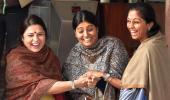'Two powerful men shaking hands with two powerful women as equals. This photograph made me very happy,' says Aakar Patel.

Two stories concerning defence and what is called strategic affairs have been in the news recently.
One is the story on the purchase of the fighter plane Rafale from France, and the other is the dialogue India had with the United States called 2+2.
I wanted to look at the former, but not from the strategic affairs angle. I'd like to focus on something different.
These things usually are of interest to only the small community of people who report on and study international relations. This group was very excited by the implications of the 2+2 meeting because apparently it will lead to all sorts of new things.
The narrowness of this group is reflected in one national newspaper's report of the event. The first line was: 'Many in India's strategic community could not contain their euphoria at the signing of the COMCASA, the India-specific formulation of CISMOA, during the just-concluded 2+2 India-US dialogue.'
How many Indians know what COMCASA or CISMOA is or what 2+2 is?
Probably 1 in one lakh, and actually fewer even than that. Since this piece is not about the security aspects or defence scandals, we will not take a look at what COMCASA and CISMOA mean.
I was interested in the photograph that accompanied the report. It had four individuals, the defence secretary and secretary of state of the United States and the defence minister and foreign minister of India.
The ranks of these individuals is the same, meaning that the secretary in the US is the same as the Cabinet ranked minister in India. We are often accused as a nation and a culture of not wanting to engage with those who are beneath us.
The former ambassador and scholar of Indo-American relations, Dennis Kux, has written that Indian diplomats usually do not want to discuss with an American official of lower rank, even if the American official was authorised to take a decision in the matter at hand.
Indians would rather engage with their peer, even if the resultant meeting is indecisive.
This was obviously not the case in our 2+2 meeting and I think a lot of people in the strategic affairs community would have been delighted that mighty America had sent its two most powerful individuals after the president to Delhi to engage with us, and that also at ministerial level.
Again, my interest is not in such power play aspects, but something altogether different.
The photograph was of the four individuals standing together and facing the audience. On the left were America's Secretary of State Mike Pompeo and Secretary of Defence Jim Mattis, who are both white men.
Mattis is a former general in the army. Pompeo is also a former army man who was at one time head of the American spying agency, the CIA.
To the right were India's foreign minster and India's defence minister. Both were women.
One from the north (Sushma Swaraj) and the other from the south (Nirmala Sitharaman).
Both are self-made and powerful individuals, not dependent on anyone for their rise to important and powerful positions.
Two powerful men shaking hands with two powerful women as equals. This photograph made me very happy.
I do not usually like to read about defence issues because I think it is a frightening waste of money in a nation with few resources. And also that this expense usually happens to benefit the narrow interests of wealthy individuals (as the other story on defence is showing).
But this story and specifically this 2+2 photograph pleased me greatly.
Like the rest of the world we live in a place of great inequality.
In the United States, the dominance of white men is evident across their culture. There is not much space for women and there is certainly very little space for people of colour and of different faith.
The same is true in India. That photograph was not fully representative of this government, and I can off hand think of only one other powerful woman minister (Smriti Z Irani) but it showed what was possible.
Certainly the lack of adequate representation of women from much of our politics is not because of a lack of talent. Swaraj and Sitharaman and Irani -- and Mayawati and Mamata Banerjee and others in the Opposition -- disprove that comprehensively.
It is purely because of a lack of opportunity.
Moments like the 2+2 meeting should make us aware of it, and it should make us insist to all political parties that they actively include more women if they want our support and our vote.
Aakar Patel -- winner of the 2018 Prem Bhatia Award for Political Reporting -- is Executive Director, Amnesty International India. The views expressed here are his own.
- You can read Aakar's earlier columns here.










